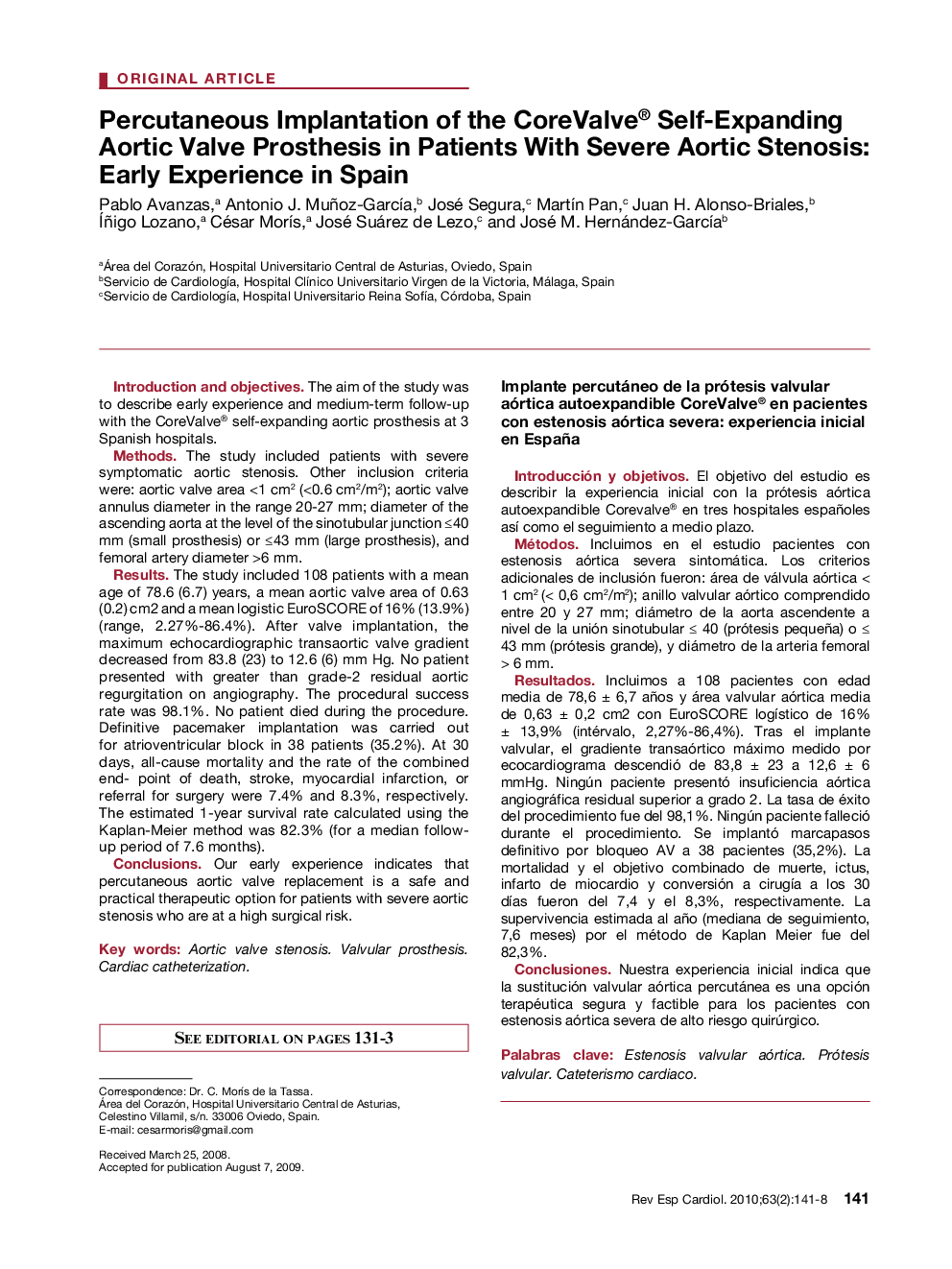| Article ID | Journal | Published Year | Pages | File Type |
|---|---|---|---|---|
| 3017323 | Revista Española de Cardiología (English Edition) | 2010 | 8 Pages |
Introduction and objectivesThe aim of the study was to describe early experience and medium-term follow-up with the CoreValve® self-expanding aortic prosthesis at 3 Spanish hospitals.MethodsThe study included patients with severe symptomatic aortic stenosis. Other inclusion criteria were: aortic valve area <1 cm2 (<0.6 cm2/m2); aortic valve annulus diameter in the range 20-27 mm; diameter of the ascending aorta at the level of the sinotubular junction ≤40 mm (small prosthesis) or ≤43 mm (large prosthesis), and femoral artery diameter >6 mm.ResultsThe study included 108 patients with a mean age of 78.6 (6.7) years, a mean aortic valve area of 0.63 (0.2) cm2 and a mean logistic EuroSCORE of 16% (13.9%) (range, 2.27%-86.4%). After valve implantation, the maximum echocardiographic transaortic valve gradient decreased from 83.8 (23) to 12.6 (6) mm Hg. No patient presented with greater than grade-2 residual aortic regurgitation on angiography. The procedural success rate was 98.1%. No patient died during the procedure. Definitive pacemaker implantation was carried out for atrioventricular block in 38 patients (35.2%). At 30 days, all-cause mortality and the rate of the combined end- point of death, stroke, myocardial infarction, or referral for surgery were 7.4% and 8.3%, respectively. The estimated 1-year survival rate calculated using the Kaplan-Meier method was 82.3% (for a median follow-up period of 7.6 months).ConclusionsOur early experience indicates that percutaneous aortic valve replacement is a safe and practical therapeutic option for patients with severe aortic stenosis who are at a high surgical risk.
Introducción y objetivosEl objetivo del estudio es describir la experiencia inicial con la prótesis aórtica autoexpandible Corevalve® en tres hospitales españoles así como el seguimiento a medio plazo.MétodosIncluimos en el estudio pacientes con estenosis aórtica severa sintomática. Los criterios adicionales de inclusión fueron: área de válvula aórtica < 1 cm2 (< 0,6 cm2/m2); anillo valvular aórtico comprendido entre 20 y 27 mm; diámetro de la aorta ascendente a nivel de la unión sinotubular ≤ 40 (prótesis pequeña) o ≤ 43 mm (prótesis grande), y diámetro de la arteria femoral > 6 mm.ResultadosIncluimos a 108 pacientes con edad media de 78,6 ± 6,7 años y área valvular aórtica media de 0,63 ± 0,2 cm2 con EuroSCORE logístico de 16% ± 13,9% (intérvalo, 2,27%-86,4%). Tras el implante valvular, el gradiente transaórtico máximo medido por ecocardiograma descendió de 83,8 ± 23 a 12,6 ± 6 mmHg. Ningún paciente presentó insuficiencia aórtica angiográfica residual superior a grado 2. La tasa de éxito del procedimiento fue del 98,1%. Ningún paciente falleció durante el procedimiento. Se implantó marcapasos definitivo por bloqueo AV a 38 pacientes (35,2%). La mortalidad y el objetivo combinado de muerte, ictus, infarto de miocardio y conversión a cirugía a los 30 días fueron del 7,4 y el 8,3%, respectivamente. La supervivencia estimada al año (mediana de seguimiento, 7,6 meses) por el método de Kaplan Meier fue del 82,3%.ConclusionesNuestra experiencia inicial indica que la sustitución valvular aórtica percutánea es una opción terapéutica segura y factible para los pacientes con estenosis aórtica severa de alto riesgo quirúrgico.
